Visitor Attraction Management: Development, Impacts, and Strategies
VerifiedAdded on 2024/04/25
|25
|5587
|451
Report
AI Summary
This report provides a comprehensive analysis of visitor attraction management within the UK's tourism industry. It begins by discussing the various types of visitor attractions, including historico-cultural, environmental, and entertainment sites, and analyzes their importance in driving tourism and economic growth. The report then delves into the needs and motivations of different visitor types, such as business, education, health, adventure, leisure, sports, and religious visitors, and examines the impacts of tourism on visitor attractions, both positive (social, economic, and environmental benefits) and negative (social disruption, economic instability, and environmental degradation). Furthermore, it explores the effect of different theories of tourist motivation on the management of visitor attractions and discusses the processes and potential issues involved in the development of visitor attractions. Finally, the report outlines various visitor management strategies and techniques in relation to sustainability, emphasizing the importance of balancing tourism growth with environmental protection and community well-being. This analysis highlights the crucial role of effective visitor attraction management in fostering a thriving and sustainable tourism sector in the UK.
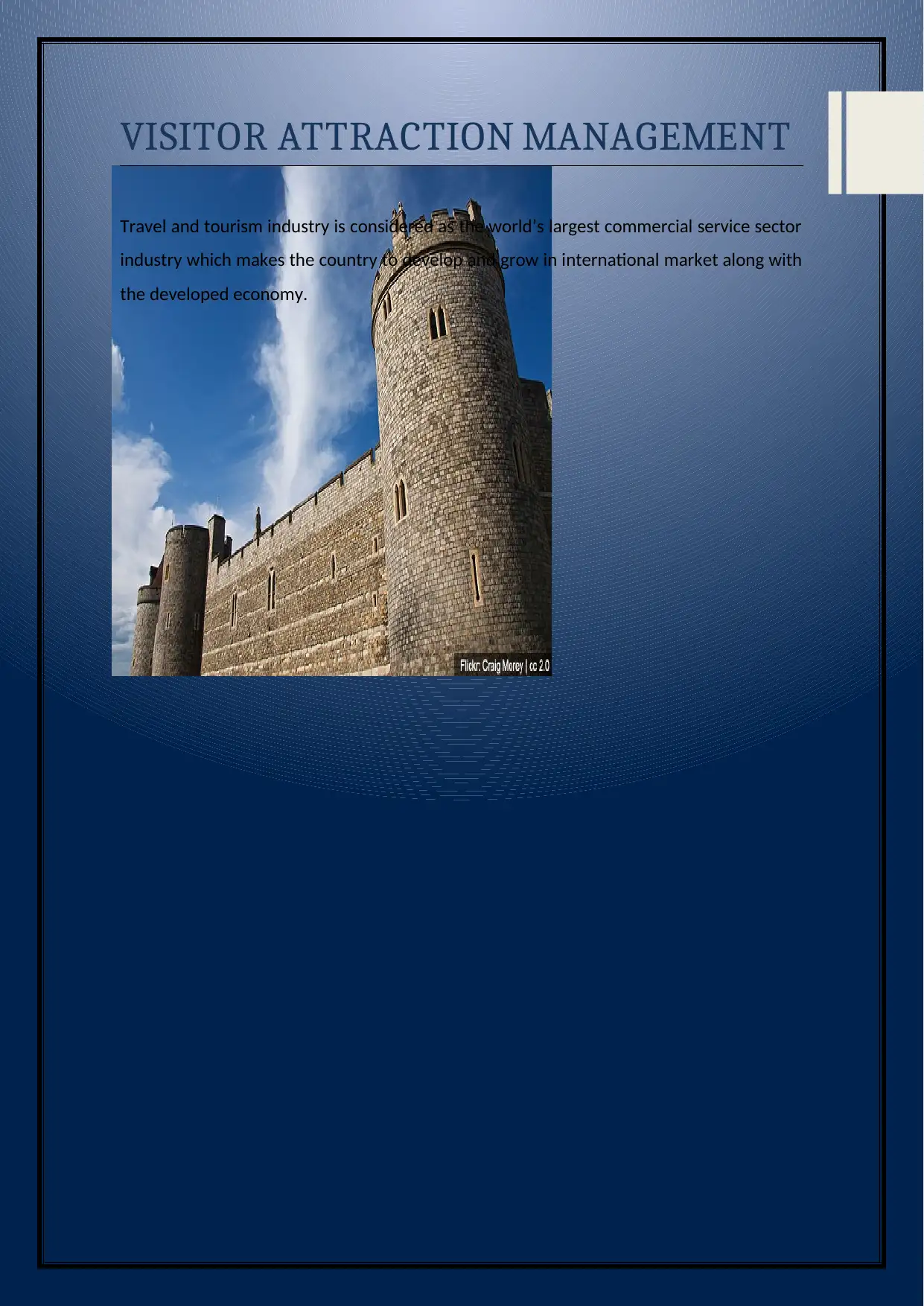
VISITOR ATTRACTION MANAGEMENT
Travel and tourism industry is considered as the world’s largest commercial service sector
industry which makes the country to develop and grow in international market along with
the developed economy.
Travel and tourism industry is considered as the world’s largest commercial service sector
industry which makes the country to develop and grow in international market along with
the developed economy.
Paraphrase This Document
Need a fresh take? Get an instant paraphrase of this document with our AI Paraphraser
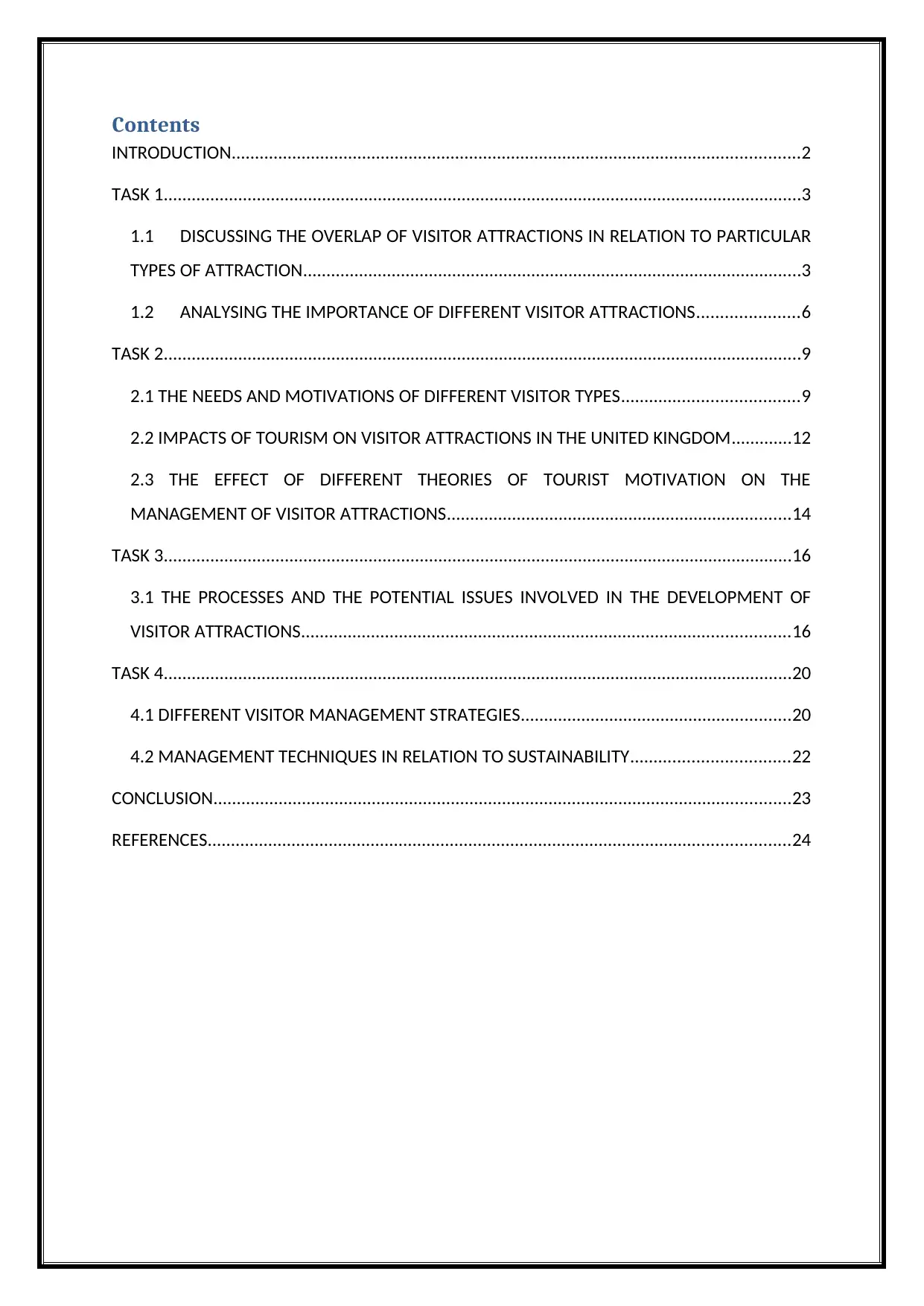
Contents
INTRODUCTION..........................................................................................................................2
TASK 1.........................................................................................................................................3
1.1 DISCUSSING THE OVERLAP OF VISITOR ATTRACTIONS IN RELATION TO PARTICULAR
TYPES OF ATTRACTION...........................................................................................................3
1.2 ANALYSING THE IMPORTANCE OF DIFFERENT VISITOR ATTRACTIONS......................6
TASK 2.........................................................................................................................................9
2.1 THE NEEDS AND MOTIVATIONS OF DIFFERENT VISITOR TYPES......................................9
2.2 IMPACTS OF TOURISM ON VISITOR ATTRACTIONS IN THE UNITED KINGDOM.............12
2.3 THE EFFECT OF DIFFERENT THEORIES OF TOURIST MOTIVATION ON THE
MANAGEMENT OF VISITOR ATTRACTIONS..........................................................................14
TASK 3.......................................................................................................................................16
3.1 THE PROCESSES AND THE POTENTIAL ISSUES INVOLVED IN THE DEVELOPMENT OF
VISITOR ATTRACTIONS.........................................................................................................16
TASK 4.......................................................................................................................................20
4.1 DIFFERENT VISITOR MANAGEMENT STRATEGIES..........................................................20
4.2 MANAGEMENT TECHNIQUES IN RELATION TO SUSTAINABILITY..................................22
CONCLUSION............................................................................................................................23
REFERENCES.............................................................................................................................24
INTRODUCTION..........................................................................................................................2
TASK 1.........................................................................................................................................3
1.1 DISCUSSING THE OVERLAP OF VISITOR ATTRACTIONS IN RELATION TO PARTICULAR
TYPES OF ATTRACTION...........................................................................................................3
1.2 ANALYSING THE IMPORTANCE OF DIFFERENT VISITOR ATTRACTIONS......................6
TASK 2.........................................................................................................................................9
2.1 THE NEEDS AND MOTIVATIONS OF DIFFERENT VISITOR TYPES......................................9
2.2 IMPACTS OF TOURISM ON VISITOR ATTRACTIONS IN THE UNITED KINGDOM.............12
2.3 THE EFFECT OF DIFFERENT THEORIES OF TOURIST MOTIVATION ON THE
MANAGEMENT OF VISITOR ATTRACTIONS..........................................................................14
TASK 3.......................................................................................................................................16
3.1 THE PROCESSES AND THE POTENTIAL ISSUES INVOLVED IN THE DEVELOPMENT OF
VISITOR ATTRACTIONS.........................................................................................................16
TASK 4.......................................................................................................................................20
4.1 DIFFERENT VISITOR MANAGEMENT STRATEGIES..........................................................20
4.2 MANAGEMENT TECHNIQUES IN RELATION TO SUSTAINABILITY..................................22
CONCLUSION............................................................................................................................23
REFERENCES.............................................................................................................................24

INTRODUCTION
This report is based on the concept of managing the visitor's attraction in the UK. As all the
countries are developing in many aspects along with the development of their tourism
sector, this describes that tourism sector is considered as one of the most economically
favourable sectors for the countries. It is very important for the countries to manage their
attention gaining places and things to maintain the growth of tourism sector. One more
thing that is important for countries to develop their tourism sector is to manage the
visitors. This report is based on the development of the personal understanding regarding
the types of visitors and attractive things and places to visitors. There are some impacts
faced by the countries because of tourist which can be handled by tourists’ motivational
theories. The factors that affect the development process of the country are discussed in
this report along with management techniques that hinder and foster the sustainability of
the country in tourism development.
The visitors’ attractions are considered as the very important sites to develop tourism sector
and increase the economy of the country. Visitor’s attraction management is a process that
helps us to classify the variety of visitor’s attraction and optimal solutions to the negative
impacts. The marketing department of tourism sector plays a very vital role in the
development of the tourism industry (Dewhurst and Thwaites, 2014). The proper adoption
of the management strategies and techniques to maintain and develop the tourism sector
will help the countries to increase their tourist visit and develop economically.
This report is based on the concept of managing the visitor's attraction in the UK. As all the
countries are developing in many aspects along with the development of their tourism
sector, this describes that tourism sector is considered as one of the most economically
favourable sectors for the countries. It is very important for the countries to manage their
attention gaining places and things to maintain the growth of tourism sector. One more
thing that is important for countries to develop their tourism sector is to manage the
visitors. This report is based on the development of the personal understanding regarding
the types of visitors and attractive things and places to visitors. There are some impacts
faced by the countries because of tourist which can be handled by tourists’ motivational
theories. The factors that affect the development process of the country are discussed in
this report along with management techniques that hinder and foster the sustainability of
the country in tourism development.
The visitors’ attractions are considered as the very important sites to develop tourism sector
and increase the economy of the country. Visitor’s attraction management is a process that
helps us to classify the variety of visitor’s attraction and optimal solutions to the negative
impacts. The marketing department of tourism sector plays a very vital role in the
development of the tourism industry (Dewhurst and Thwaites, 2014). The proper adoption
of the management strategies and techniques to maintain and develop the tourism sector
will help the countries to increase their tourist visit and develop economically.
⊘ This is a preview!⊘
Do you want full access?
Subscribe today to unlock all pages.

Trusted by 1+ million students worldwide

TASK 1
It is the responsibility of the tourism consultant for visit Britain, to shape England's leisure
industrial product and increment the capacity and worth of tourism exports which will help
the country to develop economically. This article will help to describe the various tourist
attractions in the UK.
It is the responsibility of the tourism consultant for visit Britain, to shape England's leisure
industrial product and increment the capacity and worth of tourism exports which will help
the country to develop economically. This article will help to describe the various tourist
attractions in the UK.
Paraphrase This Document
Need a fresh take? Get an instant paraphrase of this document with our AI Paraphraser

1.1 DISCUSSING THE OVERLAP OF VISITOR ATTRACTIONS IN RELATION TO
PARTICULAR TYPES OF ATTRACTION
PARTICULAR TYPES OF ATTRACTION
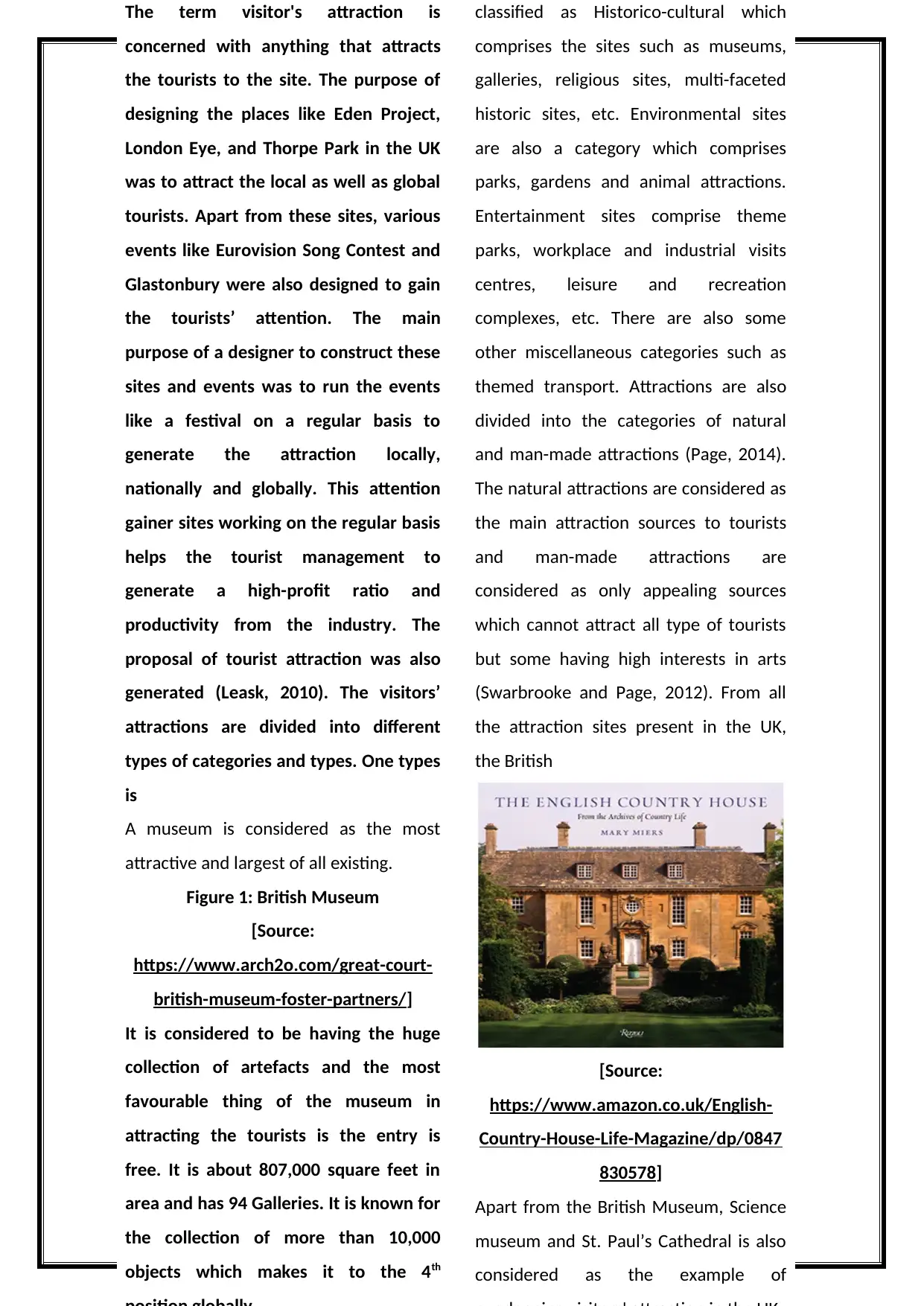
The term visitor's attraction is
concerned with anything that attracts
the tourists to the site. The purpose of
designing the places like Eden Project,
London Eye, and Thorpe Park in the UK
was to attract the local as well as global
tourists. Apart from these sites, various
events like Eurovision Song Contest and
Glastonbury were also designed to gain
the tourists’ attention. The main
purpose of a designer to construct these
sites and events was to run the events
like a festival on a regular basis to
generate the attraction locally,
nationally and globally. This attention
gainer sites working on the regular basis
helps the tourist management to
generate a high-profit ratio and
productivity from the industry. The
proposal of tourist attraction was also
generated (Leask, 2010). The visitors’
attractions are divided into different
types of categories and types. One types
is
A museum is considered as the most
attractive and largest of all existing.
Figure 1: British Museum
[Source:
https://www.arch2o.com/great-court-
british-museum-foster-partners/]
It is considered to be having the huge
collection of artefacts and the most
favourable thing of the museum in
attracting the tourists is the entry is
free. It is about 807,000 square feet in
area and has 94 Galleries. It is known for
the collection of more than 10,000
objects which makes it to the 4th
classified as Historico-cultural which
comprises the sites such as museums,
galleries, religious sites, multi-faceted
historic sites, etc. Environmental sites
are also a category which comprises
parks, gardens and animal attractions.
Entertainment sites comprise theme
parks, workplace and industrial visits
centres, leisure and recreation
complexes, etc. There are also some
other miscellaneous categories such as
themed transport. Attractions are also
divided into the categories of natural
and man-made attractions (Page, 2014).
The natural attractions are considered as
the main attraction sources to tourists
and man-made attractions are
considered as only appealing sources
which cannot attract all type of tourists
but some having high interests in arts
(Swarbrooke and Page, 2012). From all
the attraction sites present in the UK,
the British
[Source:
https://www.amazon.co.uk/English-
Country-House-Life-Magazine/dp/0847
830578]
Apart from the British Museum, Science
museum and St. Paul’s Cathedral is also
considered as the example of
concerned with anything that attracts
the tourists to the site. The purpose of
designing the places like Eden Project,
London Eye, and Thorpe Park in the UK
was to attract the local as well as global
tourists. Apart from these sites, various
events like Eurovision Song Contest and
Glastonbury were also designed to gain
the tourists’ attention. The main
purpose of a designer to construct these
sites and events was to run the events
like a festival on a regular basis to
generate the attraction locally,
nationally and globally. This attention
gainer sites working on the regular basis
helps the tourist management to
generate a high-profit ratio and
productivity from the industry. The
proposal of tourist attraction was also
generated (Leask, 2010). The visitors’
attractions are divided into different
types of categories and types. One types
is
A museum is considered as the most
attractive and largest of all existing.
Figure 1: British Museum
[Source:
https://www.arch2o.com/great-court-
british-museum-foster-partners/]
It is considered to be having the huge
collection of artefacts and the most
favourable thing of the museum in
attracting the tourists is the entry is
free. It is about 807,000 square feet in
area and has 94 Galleries. It is known for
the collection of more than 10,000
objects which makes it to the 4th
classified as Historico-cultural which
comprises the sites such as museums,
galleries, religious sites, multi-faceted
historic sites, etc. Environmental sites
are also a category which comprises
parks, gardens and animal attractions.
Entertainment sites comprise theme
parks, workplace and industrial visits
centres, leisure and recreation
complexes, etc. There are also some
other miscellaneous categories such as
themed transport. Attractions are also
divided into the categories of natural
and man-made attractions (Page, 2014).
The natural attractions are considered as
the main attraction sources to tourists
and man-made attractions are
considered as only appealing sources
which cannot attract all type of tourists
but some having high interests in arts
(Swarbrooke and Page, 2012). From all
the attraction sites present in the UK,
the British
[Source:
https://www.amazon.co.uk/English-
Country-House-Life-Magazine/dp/0847
830578]
Apart from the British Museum, Science
museum and St. Paul’s Cathedral is also
considered as the example of
⊘ This is a preview!⊘
Do you want full access?
Subscribe today to unlock all pages.

Trusted by 1+ million students worldwide
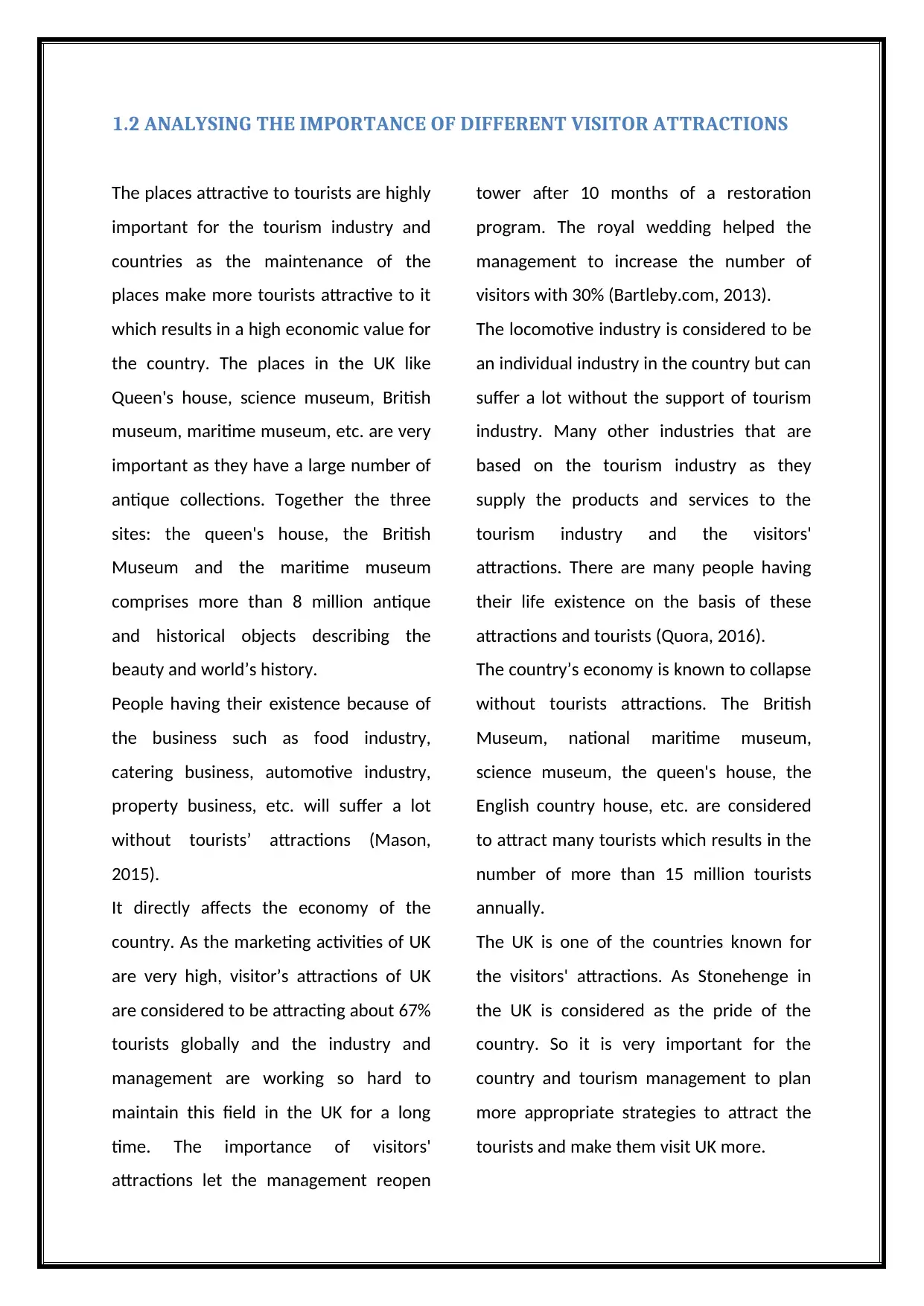
1.2 ANALYSING THE IMPORTANCE OF DIFFERENT VISITOR ATTRACTIONS
The places attractive to tourists are highly
important for the tourism industry and
countries as the maintenance of the
places make more tourists attractive to it
which results in a high economic value for
the country. The places in the UK like
Queen's house, science museum, British
museum, maritime museum, etc. are very
important as they have a large number of
antique collections. Together the three
sites: the queen's house, the British
Museum and the maritime museum
comprises more than 8 million antique
and historical objects describing the
beauty and world’s history.
People having their existence because of
the business such as food industry,
catering business, automotive industry,
property business, etc. will suffer a lot
without tourists’ attractions (Mason,
2015).
It directly affects the economy of the
country. As the marketing activities of UK
are very high, visitor’s attractions of UK
are considered to be attracting about 67%
tourists globally and the industry and
management are working so hard to
maintain this field in the UK for a long
time. The importance of visitors'
attractions let the management reopen
tower after 10 months of a restoration
program. The royal wedding helped the
management to increase the number of
visitors with 30% (Bartleby.com, 2013).
The locomotive industry is considered to be
an individual industry in the country but can
suffer a lot without the support of tourism
industry. Many other industries that are
based on the tourism industry as they
supply the products and services to the
tourism industry and the visitors'
attractions. There are many people having
their life existence on the basis of these
attractions and tourists (Quora, 2016).
The country’s economy is known to collapse
without tourists attractions. The British
Museum, national maritime museum,
science museum, the queen's house, the
English country house, etc. are considered
to attract many tourists which results in the
number of more than 15 million tourists
annually.
The UK is one of the countries known for
the visitors' attractions. As Stonehenge in
the UK is considered as the pride of the
country. So it is very important for the
country and tourism management to plan
more appropriate strategies to attract the
tourists and make them visit UK more.
The places attractive to tourists are highly
important for the tourism industry and
countries as the maintenance of the
places make more tourists attractive to it
which results in a high economic value for
the country. The places in the UK like
Queen's house, science museum, British
museum, maritime museum, etc. are very
important as they have a large number of
antique collections. Together the three
sites: the queen's house, the British
Museum and the maritime museum
comprises more than 8 million antique
and historical objects describing the
beauty and world’s history.
People having their existence because of
the business such as food industry,
catering business, automotive industry,
property business, etc. will suffer a lot
without tourists’ attractions (Mason,
2015).
It directly affects the economy of the
country. As the marketing activities of UK
are very high, visitor’s attractions of UK
are considered to be attracting about 67%
tourists globally and the industry and
management are working so hard to
maintain this field in the UK for a long
time. The importance of visitors'
attractions let the management reopen
tower after 10 months of a restoration
program. The royal wedding helped the
management to increase the number of
visitors with 30% (Bartleby.com, 2013).
The locomotive industry is considered to be
an individual industry in the country but can
suffer a lot without the support of tourism
industry. Many other industries that are
based on the tourism industry as they
supply the products and services to the
tourism industry and the visitors'
attractions. There are many people having
their life existence on the basis of these
attractions and tourists (Quora, 2016).
The country’s economy is known to collapse
without tourists attractions. The British
Museum, national maritime museum,
science museum, the queen's house, the
English country house, etc. are considered
to attract many tourists which results in the
number of more than 15 million tourists
annually.
The UK is one of the countries known for
the visitors' attractions. As Stonehenge in
the UK is considered as the pride of the
country. So it is very important for the
country and tourism management to plan
more appropriate strategies to attract the
tourists and make them visit UK more.
Paraphrase This Document
Need a fresh take? Get an instant paraphrase of this document with our AI Paraphraser
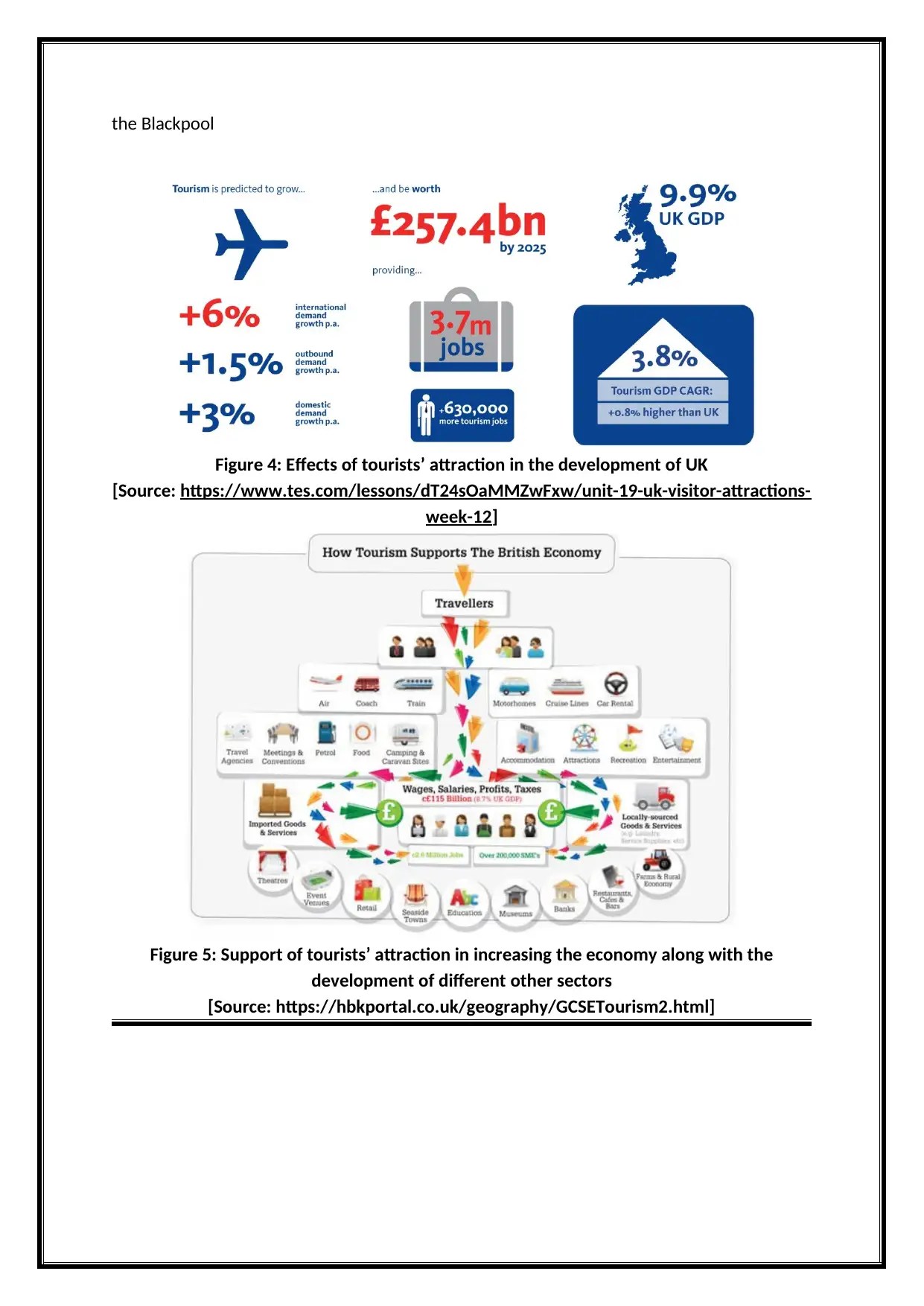
the Blackpool
Figure 4: Effects of tourists’ attraction in the development of UK
[Source: https://www.tes.com/lessons/dT24sOaMMZwFxw/unit-19-uk-visitor-attractions-
week-12]
Figure 5: Support of tourists’ attraction in increasing the economy along with the
development of different other sectors
[Source: https://hbkportal.co.uk/geography/GCSETourism2.html]
Figure 4: Effects of tourists’ attraction in the development of UK
[Source: https://www.tes.com/lessons/dT24sOaMMZwFxw/unit-19-uk-visitor-attractions-
week-12]
Figure 5: Support of tourists’ attraction in increasing the economy along with the
development of different other sectors
[Source: https://hbkportal.co.uk/geography/GCSETourism2.html]

TASK 2
2.1 THE NEEDS AND MOTIVATIONS OF DIFFERENT VISITOR TYPES
Tourists are the one who travels to one place away from their native in order to attain some
leisure time, business tours or several other reasons. The visitors are categorized in
accordance with their needs for travelling to any tourist destination or with different
reasons and motives to visit any place. There are several types of tourists with variable
needs and motivation such as:
Business visitor: Traveling in context to business tour is related to the trips visitors
do to fulfil their work purpose. The term MESE that explains the needs of business
tourist such as meetings, exhibitions and special events are the reason such tourist
visit to any tourist destination (Mason, 2015).
Education visitor: Education visitor is the one who travels to any place so that they
could study on any topic or improve their knowledge about that destination. Such
visitors may also be the one who wants to attend the seminars, events that are
conducted at any tourist destination like in British Museum, the National Maritime
Museum in the UK to gain new skills and enhance the existing ones.
Health visitor: The health or medical visitors are the one who travels to another
country in order to get better health treatment as compared to their place with good
facilities and lower cost (Leong, et al. 2015). Also, such tourist has the motive to
recover from any disease in a better and healthier environment.
Adventure visitor: These are the travellers who visit any tourist destination in order
to gain some exiting and never had experiences such as these people want to
participate in adventurous activities that could also be dangerous like river rafting,
mountain climbing, trekking, skydiving, bungee jumping etc.
2.1 THE NEEDS AND MOTIVATIONS OF DIFFERENT VISITOR TYPES
Tourists are the one who travels to one place away from their native in order to attain some
leisure time, business tours or several other reasons. The visitors are categorized in
accordance with their needs for travelling to any tourist destination or with different
reasons and motives to visit any place. There are several types of tourists with variable
needs and motivation such as:
Business visitor: Traveling in context to business tour is related to the trips visitors
do to fulfil their work purpose. The term MESE that explains the needs of business
tourist such as meetings, exhibitions and special events are the reason such tourist
visit to any tourist destination (Mason, 2015).
Education visitor: Education visitor is the one who travels to any place so that they
could study on any topic or improve their knowledge about that destination. Such
visitors may also be the one who wants to attend the seminars, events that are
conducted at any tourist destination like in British Museum, the National Maritime
Museum in the UK to gain new skills and enhance the existing ones.
Health visitor: The health or medical visitors are the one who travels to another
country in order to get better health treatment as compared to their place with good
facilities and lower cost (Leong, et al. 2015). Also, such tourist has the motive to
recover from any disease in a better and healthier environment.
Adventure visitor: These are the travellers who visit any tourist destination in order
to gain some exiting and never had experiences such as these people want to
participate in adventurous activities that could also be dangerous like river rafting,
mountain climbing, trekking, skydiving, bungee jumping etc.
⊘ This is a preview!⊘
Do you want full access?
Subscribe today to unlock all pages.

Trusted by 1+ million students worldwide

Leisure Visitor: The leisure visitors are the one who visits any place for the purpose
of fun, relaxation and enjoys their time especially from their busy schedule. These
visitors want to refresh and relax with ease and comfort by enjoying break they got
from there busy and stressful life. The tourist for leisure travel usually is noticed by
residing in lavish and premium hotels, enjoying the beach life, a good room with a
nice view and experiencing the local visitor's attractions.
Sports and recreation visitor: These are the visitors who are sports lovers and want
to participate or either watch some sports events those sports programs could be
cricket matches, swimming, Olympics, tennis championship, Soccer world cup etc.
Religious visitors: The visitors who had more interest in the religious aspects of any
place and want to explore that destination in order to understand the religion of that
place or visit in order to fulfil their religious needs are the religious visitors (Bond, et
al. 2015). The globe has many religious destinations like Westminster cathedral,
BAPS Shri Swaminarayan Mandir in London etc.
Figure 5: Types of visitors
of fun, relaxation and enjoys their time especially from their busy schedule. These
visitors want to refresh and relax with ease and comfort by enjoying break they got
from there busy and stressful life. The tourist for leisure travel usually is noticed by
residing in lavish and premium hotels, enjoying the beach life, a good room with a
nice view and experiencing the local visitor's attractions.
Sports and recreation visitor: These are the visitors who are sports lovers and want
to participate or either watch some sports events those sports programs could be
cricket matches, swimming, Olympics, tennis championship, Soccer world cup etc.
Religious visitors: The visitors who had more interest in the religious aspects of any
place and want to explore that destination in order to understand the religion of that
place or visit in order to fulfil their religious needs are the religious visitors (Bond, et
al. 2015). The globe has many religious destinations like Westminster cathedral,
BAPS Shri Swaminarayan Mandir in London etc.
Figure 5: Types of visitors
Paraphrase This Document
Need a fresh take? Get an instant paraphrase of this document with our AI Paraphraser

{Source: https://rashidfaridi.com/2017/03/20/15754/}
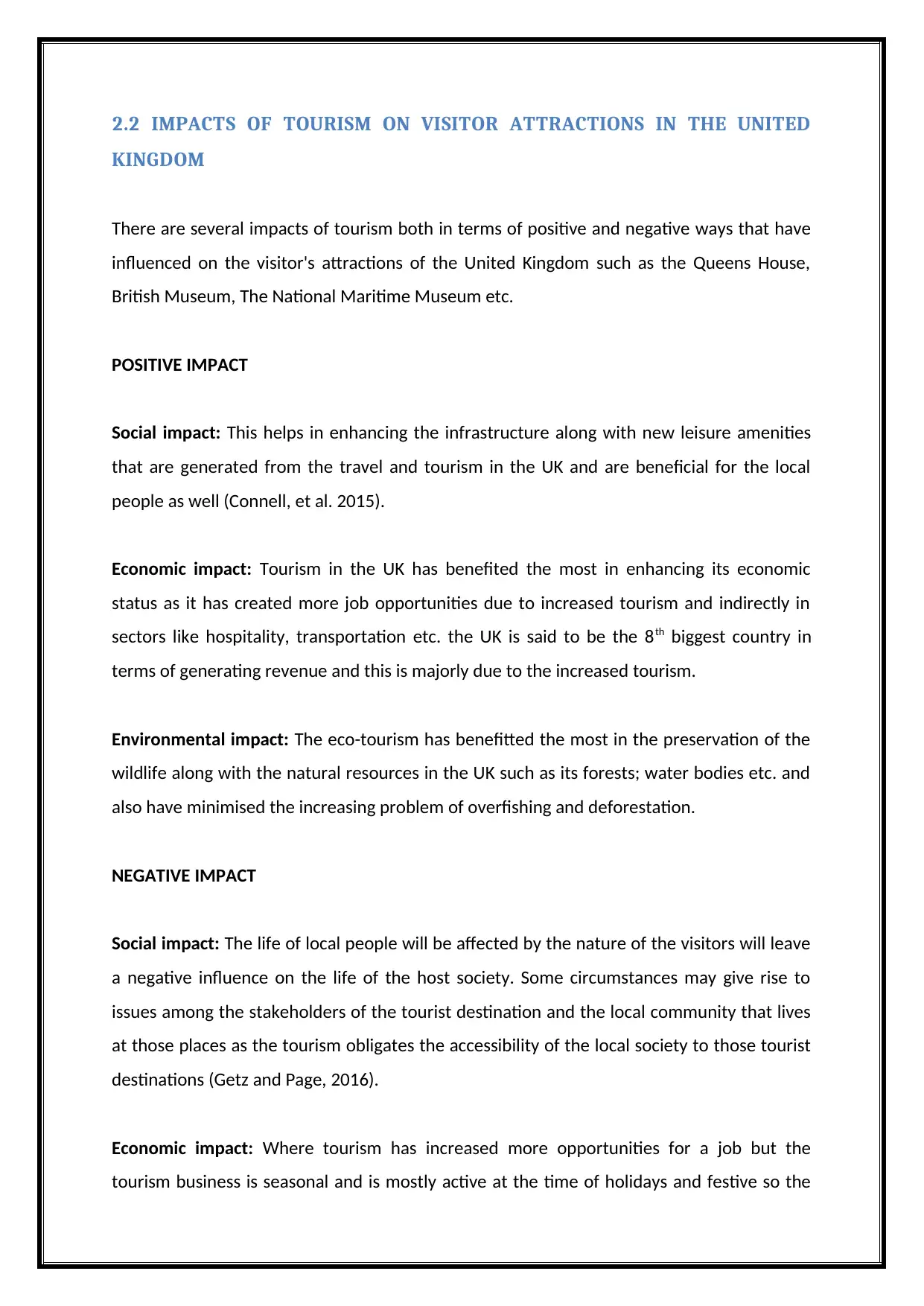
2.2 IMPACTS OF TOURISM ON VISITOR ATTRACTIONS IN THE UNITED
KINGDOM
There are several impacts of tourism both in terms of positive and negative ways that have
influenced on the visitor's attractions of the United Kingdom such as the Queens House,
British Museum, The National Maritime Museum etc.
POSITIVE IMPACT
Social impact: This helps in enhancing the infrastructure along with new leisure amenities
that are generated from the travel and tourism in the UK and are beneficial for the local
people as well (Connell, et al. 2015).
Economic impact: Tourism in the UK has benefited the most in enhancing its economic
status as it has created more job opportunities due to increased tourism and indirectly in
sectors like hospitality, transportation etc. the UK is said to be the 8th biggest country in
terms of generating revenue and this is majorly due to the increased tourism.
Environmental impact: The eco-tourism has benefitted the most in the preservation of the
wildlife along with the natural resources in the UK such as its forests; water bodies etc. and
also have minimised the increasing problem of overfishing and deforestation.
NEGATIVE IMPACT
Social impact: The life of local people will be affected by the nature of the visitors will leave
a negative influence on the life of the host society. Some circumstances may give rise to
issues among the stakeholders of the tourist destination and the local community that lives
at those places as the tourism obligates the accessibility of the local society to those tourist
destinations (Getz and Page, 2016).
Economic impact: Where tourism has increased more opportunities for a job but the
tourism business is seasonal and is mostly active at the time of holidays and festive so the
KINGDOM
There are several impacts of tourism both in terms of positive and negative ways that have
influenced on the visitor's attractions of the United Kingdom such as the Queens House,
British Museum, The National Maritime Museum etc.
POSITIVE IMPACT
Social impact: This helps in enhancing the infrastructure along with new leisure amenities
that are generated from the travel and tourism in the UK and are beneficial for the local
people as well (Connell, et al. 2015).
Economic impact: Tourism in the UK has benefited the most in enhancing its economic
status as it has created more job opportunities due to increased tourism and indirectly in
sectors like hospitality, transportation etc. the UK is said to be the 8th biggest country in
terms of generating revenue and this is majorly due to the increased tourism.
Environmental impact: The eco-tourism has benefitted the most in the preservation of the
wildlife along with the natural resources in the UK such as its forests; water bodies etc. and
also have minimised the increasing problem of overfishing and deforestation.
NEGATIVE IMPACT
Social impact: The life of local people will be affected by the nature of the visitors will leave
a negative influence on the life of the host society. Some circumstances may give rise to
issues among the stakeholders of the tourist destination and the local community that lives
at those places as the tourism obligates the accessibility of the local society to those tourist
destinations (Getz and Page, 2016).
Economic impact: Where tourism has increased more opportunities for a job but the
tourism business is seasonal and is mostly active at the time of holidays and festive so the
⊘ This is a preview!⊘
Do you want full access?
Subscribe today to unlock all pages.

Trusted by 1+ million students worldwide
1 out of 25
Related Documents
Your All-in-One AI-Powered Toolkit for Academic Success.
+13062052269
info@desklib.com
Available 24*7 on WhatsApp / Email
![[object Object]](/_next/static/media/star-bottom.7253800d.svg)
Unlock your academic potential
Copyright © 2020–2025 A2Z Services. All Rights Reserved. Developed and managed by ZUCOL.





